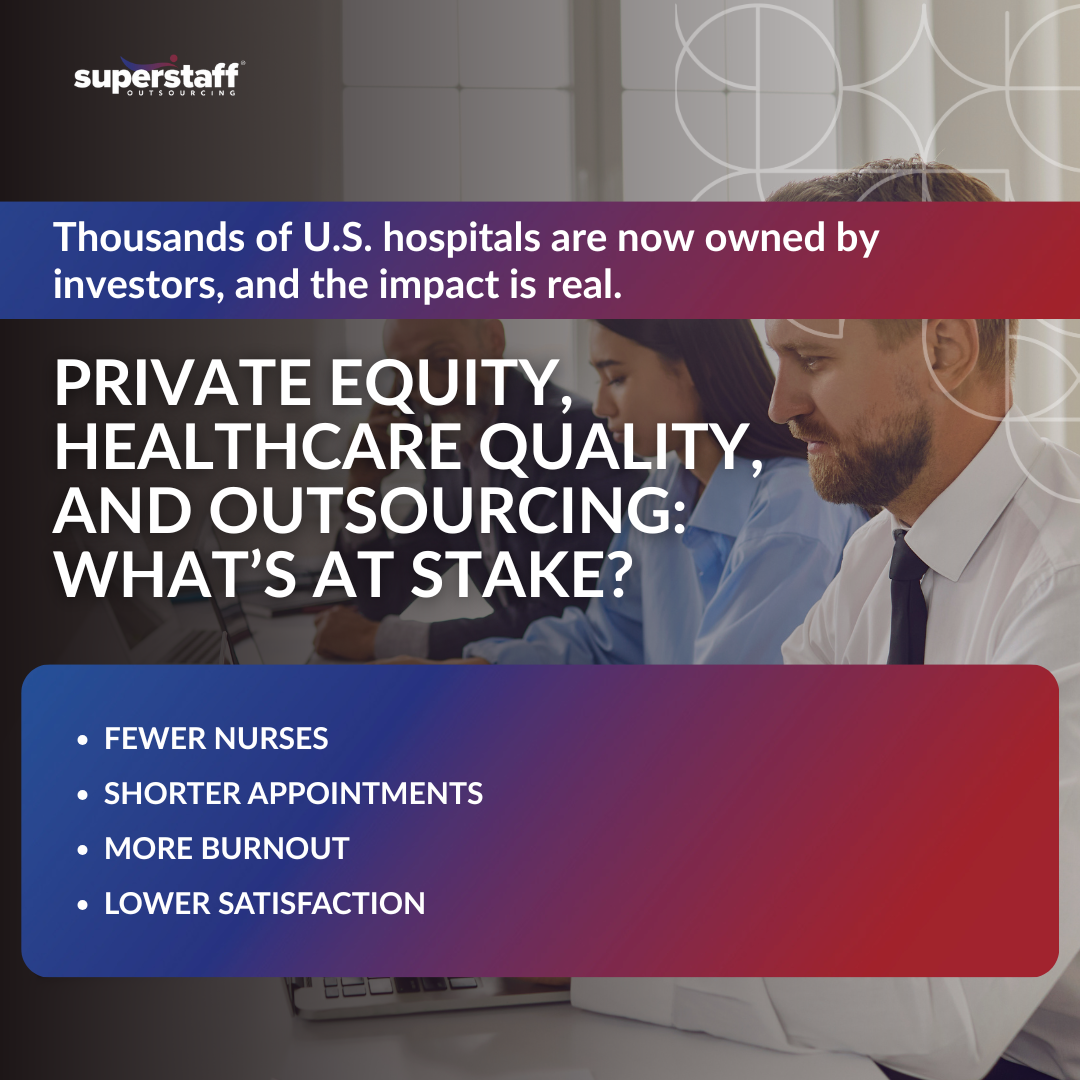
Private equity (PE) is changing healthcare, and not always for the better. Behind the business deals and promises of “efficiency,” many healthcare workers and patients are feeling the strain. When profits become the focus, patient care often takes a hit.
In recent years, private equity firms have been buying hospitals, clinics, and specialty practices at a rapid pace. These firms are focused on cutting costs and increasing value quickly, which can lead to fewer staff, more burnout, and lower care standards.
This is where healthcare quality and outsourcing come together. By outsourcing non-clinical tasks, providers can stay focused on care while handling rising pressure from investors.
This article explores how outsourcing can help healthcare organizations protect patient care, even in the face of aggressive private equity moves.

Why Private Equity Is Entering Healthcare
Private equity firms are drawn to the healthcare industry for several reasons:
- Consistent demand – Healthcare remains essential regardless of economic conditions.
- Opportunities for consolidation – Many small or independent providers are prime targets for buyouts and mergers.
- Attractive short-term returns – According to Bain & Company, private equity funds targeting the healthcare sector achieved an average internal rate of return (IRR) of 27% over five years. No wonder investors looking for quick returns see healthcare as a smart and profitable opportunity.
However, because PE firms typically aim to boost profits and exit within a few years, this short-term financial focus can clash with the long-term priorities of patient care.
Risks to Patient Care from Private Equity Investment
The risks of cost-cutting under private equity ownership in healthcare are becoming more visible as firms reduce expenses to boost short-term profits. While some operational efficiencies can be beneficial, cuts affecting staffing levels or essential resources can seriously affect patient care.
Key Areas of Concern
- Fewer staff: Layoffs and hiring freezes reduce the number of available caregivers.
- Increased workload: The remaining staff are asked to do more with less.
- Burnout: Stress levels rise, leading to more mistakes and lower morale.
These staffing problems show the real cost of cutting corners when it comes to patient care and private equity investments. When there aren’t enough workers or staff are stretched too thin, mistakes are more likely to happen. Patients may feel rushed during visits, and the care can feel less personal.
Over time, this can damage the trust between patients and their healthcare providers. These aren’t just “what ifs”—they’re happening more often as private equity takes over more healthcare facilities.
Financial Priorities vs. Patient-Centered Care
In healthcare organizations owned by private equity firms, financial goals often take priority over patient well-being. The pressure to deliver quick returns can shift the focus from long-term care to short-term profits.
Since PE firms are primarily focused on generating returns, decisions are often based on what boosts revenue, not what improves outcomes. Spending on staff training and professional development tends to shrink, and programs designed to enhance patient experience or safety may be delayed or scaled back because they don’t offer immediate financial benefits.
The shift seriously affects the patient experience. A study published in JAMA found that after private equity took over hospitals, patients were less satisfied with their care. Overall hospital ratings went down, and fewer patients said they would recommend those hospitals. Within three years, patient satisfaction had dropped by about five percentage points.
When revenue comes first, long-term relationships with patients and investment in staff often take a back seat. Over time, this can weaken the trust and quality that healthcare systems are built on. Providers must find ways to protect care standards, even while navigating financial pressures.
How Healthcare Quality and Outsourcing Work Together to Preserve Patient Care
Since private equity often focuses on cutting costs—even when it affects the quality of care—healthcare providers under pressure don’t need to sell off hospitals or cut clinical staff to stay financially stable. Instead, they can turn to outsourcing as a smarter, more sustainable solution.
By outsourcing non-medical tasks such as:
- Billing and coding
- Appointment scheduling
- Customer service and support
Healthcare providers can lower costs without affecting patient care. These roles are important but don’t involve direct contact with patients. Passing them on to experienced partners allows in-house teams to focus fully on delivering care.
Outsourcing helps organizations stay efficient, reduce burnout, and maintain strong care standards—all while keeping patients at the center.
Enhancing Operational Efficiency and Cost Control
Private equity ownership often demands tighter, more cost-efficient operations. Outsourcing allows healthcare providers to meet those expectations without cutting corners or compromising patient care.
Providers can reduce administrative and overhead costs by handing off time-consuming tasks like billing, documentation, and claims processing while improving accuracy and turnaround times. Outsourcing also offers the flexibility to scale support as the organization grows, making it easier to adapt to changing demands without overwhelming internal teams.
With a more efficient back-end, healthcare organizations can stay financially healthy while continuing to prioritize patients. It’s a practical way to align business needs with the core values of quality care.
Maintaining Quality Standards and Compliance
Staying compliant with healthcare rules isn’t optional—it’s essential. But critical processes like routine quality checks and audits can get overlooked under financial pressure from private equity-owned organizations.
Outsourcing these tasks helps keep everything on track. Outside partners with healthcare expertise can accurately and consistently manage documentation, reporting, and monitoring. They stay current with changing regulations and can catch potential issues early, before they turn into costly problems.
This kind of dedicated focus is often hard to maintain in-house, especially when staff are stretched thin or leadership is under pressure to meet financial goals.
Real-World Examples of Outsourcing Mitigating PE Risks
As private equity takes over more healthcare facilities, many providers are turning to healthcare quality and outsourcing strategies to ease the strain on their staff and operations. Below are examples of how organizations have leveraged outsourcing to manage both financial and operational pressures.
-
Improved Patient Coordination
Mount Sinai Health System in New York partnered with AgileOne to streamline workforce management and administrative staffing, including patient coordination. This partnership helped improve operational efficiency and patient engagement by ensuring consistent communication and scheduling across departments.
-
Faster Reimbursements, Fewer Denials
A U.S.-based physical therapy provider partnered with Invensis for medical billing and claims processing. As a result, the provider saw improvement in billing outcomes, addressing issues like uncollected revenue and administrative bottlenecks, which are common in PE-owned settings.
-
Administrative Relief Boosts Focus
The University of Kansas Health System outsourced revenue cycle management functions to R1 RCM. This move reduced administrative burdens and helped improve throughput while allowing clinical staff to focus more directly on patient care, aligning operational efficiency with quality outcomes.
Selecting the Right Healthcare Outsourcing Partner
In healthcare, cost efficiency is essential, but never at the expense of care quality. The right support partner doesn’t just complete tasks; they help protect your standards, reinforce your mission, and enhance the patient experience. Here’s what makes an outsourcing partner stand out:
-
Deep Roots in Healthcare, Not Just BPO
You don’t have time to explain why a missed follow-up call matters. Work with people who already understand how delays affect patients, how clean claims keep clinics running, and why trust is everything.
-
Compliance as a Core Value
A reliable partner embeds accuracy, HIPAA compliance, and data privacy into every process. They stay ahead of regulatory shifts and confidently handle audits, making them routine rather than stressful.
-
Quick to Adapt, Easy to Work With
Healthcare doesn’t wait. When policies shift, demand spikes, or internal needs change, you need a team that adjusts fast and keeps everything on track without missing a beat.
-
They Deliver Results That Matter
A great partner proves their value through action. They simplify daily workflows, reduce delays, and give your team more time to focus on what matters most—patient care.
Future-Proofing Healthcare in a Private Equity Era
Private equity is becoming more common in healthcare, but patient care should never come second. For many providers, maintaining quality care with outsourcing is the key to balancing efficiency with patient-centered values.
SuperStaff helps healthcare providers find the right balance between running efficiently and delivering quality care. We handle medical transcription, billing and coding, claims processing, and 24/7 call center support. We also support staffing, tech, accounting, and other essential back-office needs.
Healthcare quality and outsourcing can work hand in hand with the right partner. SuperStaff gives you the tools and support to stay strong through change, without losing sight of your mission.
Protect what matters most, your patients! Partner with SuperStaff to strengthen your operations and keep patient care at the center.






